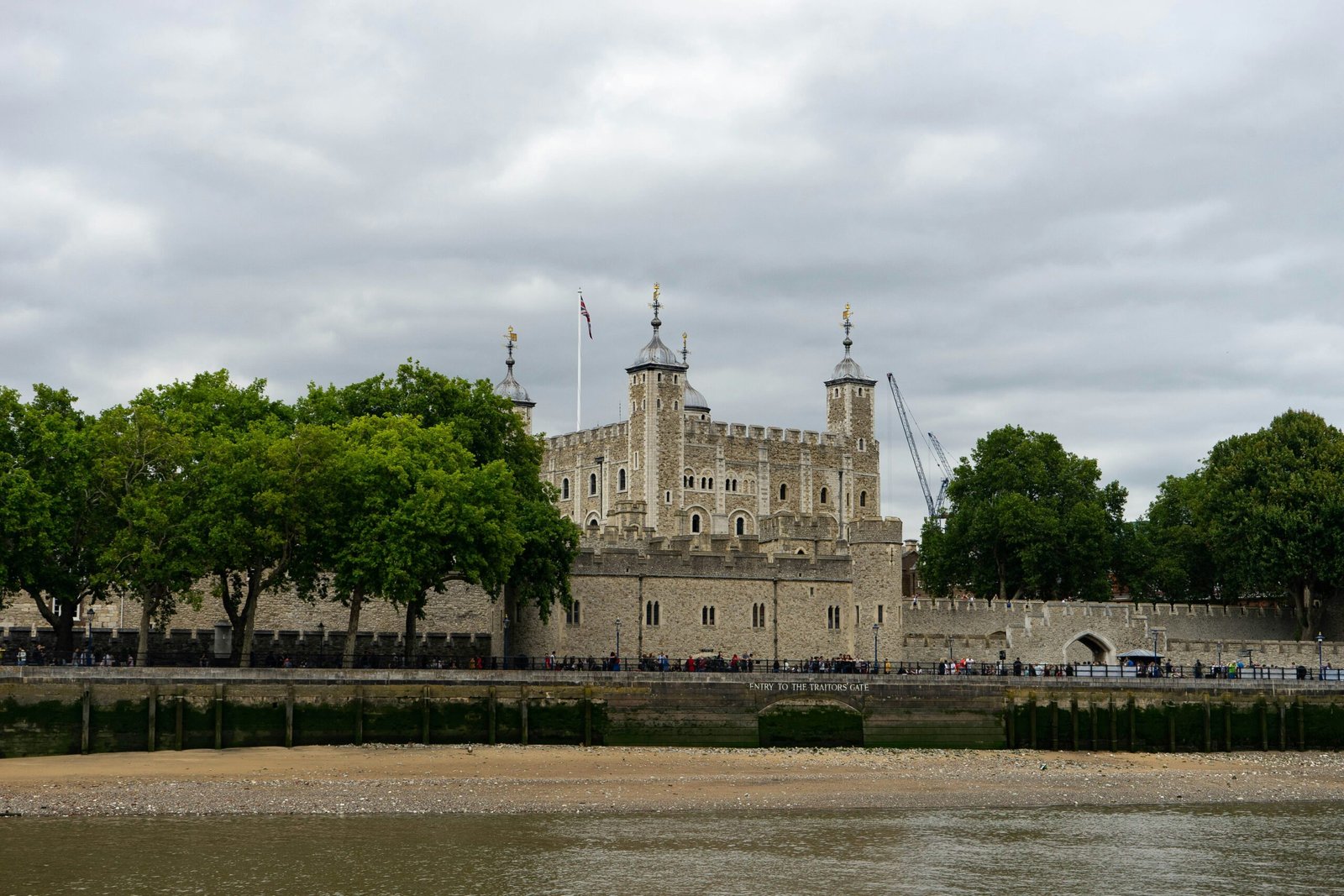
Introduction
Constructed in the 11th century by William the Conqueror, the Tower of London was initially built as a royal residence and a symbol of power. However, over the centuries, its purpose evolved, and it became a prison, a treasury, and even a menagerie. Today, it serves as a museum and a popular tourist attraction, offering visitors a glimpse into the rich and often turbulent history of England.
The Tower as a Prison
One of the most fascinating aspects of the Tower of London is its role as a prison. Throughout its history, the tower has held many high-profile prisoners, including members of the royal family, political figures, and even foreign dignitaries. The most famous prisoner to be held within its walls was undoubtedly Anne Boleyn, the second wife of King Henry VIII. Accused of adultery and treason, she was executed on the tower grounds in 1536.
The Tower as a Treasury
In addition to its use as a prison, the Tower of London also served as a treasury. The tower’s secure vaults were used to store the crown jewels, including the famous Koh-i-Noor diamond and the Imperial State Crown. Today, visitors can marvel at these priceless treasures and learn about their history and significance.
The Tower as a Menagerie
Another intriguing aspect of the Tower of London is its menagerie. For centuries, the tower housed a collection of exotic animals, gifted to the monarchs by foreign dignitaries. These animals, including lions, bears, and even elephants, were a symbol of the monarch’s power and wealth. Although the menagerie no longer exists, visitors can learn about its fascinating history and see sculptures representing the animals that once lived within the tower.
The Tower’s Architecture and Charm
Visiting the Tower of London is like stepping back in time. As you walk through its ancient walls and explore its various buildings, you can’t help but feel the weight of history. The tower’s iconic White Tower, its medieval walls, and its picturesque views of the River Thames all contribute to its unique charm.
Significance in British History
The Tower of London has witnessed countless historical events and has played a significant role in shaping the course of British history. One of the most infamous periods in the tower’s history was during the reign of King Henry VIII. It was during this time that the tower became synonymous with imprisonment and execution.
Famous Executions in the Tower
Henry VIII, known for his tumultuous love life and his desire for a male heir, used the Tower of London as a place to imprison those who posed a threat to his reign. Anne Boleyn, his second wife, was famously imprisoned in the tower on charges of adultery and treason. She was ultimately executed within the tower walls, marking a dark chapter in its history.
Other Tragic Figures
Another tragic figure who met their end in the Tower of London was Lady Jane Grey. Jane, a young and innocent girl, was manipulated by powerful figures who sought to place her on the throne after the death of Edward VI. Her reign lasted only nine days before she was imprisoned in the tower and later executed.
The Tower as a Royal Residence
But the Tower of London was not only a place of imprisonment and execution. It also served as a royal residence and a symbol of the monarchy’s power. Kings and queens throughout history have called the tower home, using its imposing structure as a statement of their authority.
The Tower as a Home for the Crown Jewels
In addition to its role as a residence, the Tower of London also housed the Crown Jewels. These precious artifacts, including the famous Koh-i-Noor diamond and the Imperial State Crown, have been kept within the tower’s walls for centuries, protected by the Yeoman Warders, also known as the Beefeaters.
The Tower Today
Today, the Tower of London continues to captivate visitors from around the world. Its ancient walls hold the secrets of centuries of history, and its stunning architecture stands as a testament to the enduring power of the British monarchy. Whether exploring the medieval White Tower, taking a tour with a Yeoman Warder, or marveling at the Crown Jewels, a visit to the Tower of London is a journey through time and an opportunity to connect with the past.
Exploring the Tower Grounds
As you continue your exploration of the Tower of London, you will come across the Medieval Palace, a fascinating part of the complex that offers a glimpse into the lives of the royals who once resided here. The palace is beautifully restored, with rooms furnished in the style of the 13th and 14th centuries. As you wander through the chambers, you can imagine the grand feasts that were held in the Great Hall or admire the intricate tapestries that adorn the walls.
The Infamous Bloody Tower
For history enthusiasts, a visit to the Tower of London would not be complete without exploring the infamous Bloody Tower. This tower has a dark and haunting history, as it was the site of several high-profile imprisonments and executions. One of the most well-known prisoners held here was Sir Walter Raleigh, who spent 13 years in captivity before being executed.
The Chapel of St. Peter ad Vincula
As you make your way through the tower, you will also discover the ancient Chapel of St. Peter ad Vincula. This small chapel holds the remains of many notable individuals, including Anne Boleyn and Catherine Howard, two of Henry VIII’s ill-fated wives. The chapel’s solemn atmosphere and historical significance make it a must-visit for those interested in Tudor history.
Tower Green and Surroundings
As you explore the grounds of the Tower of London, you may also stumble upon the picturesque Tower Green. This tranquil garden is where many executions took place, including those of Anne Boleyn and Lady Jane Grey. Today, the area is a peaceful oasis, surrounded by the imposing walls of the tower, offering visitors a moment of reflection amidst the tumultuous history of the site.
Breathtaking Views and Reflections
Before you leave, be sure to take a stroll along the tower’s famous walls, which offer breathtaking views of the surrounding city. From this vantage point, you can see iconic landmarks such as the Tower Bridge and the Shard, as well as the winding River Thames. It’s a truly unforgettable experience that provides a unique perspective on the city’s history and architecture.
Visitor Facilities
Visitor Facilities: The Tower of London offers a range of facilities to enhance your visit. There are several cafes and restaurants where you can grab a bite to eat or enjoy a cup of tea. The gift shop is a great place to pick up souvenirs and mementos of your visit. Additionally, there are cloakrooms where you can store your belongings if needed.
Exhibitions and Attractions
Exhibitions and Attractions: The tower is home to a variety of exhibitions and attractions that showcase its rich history. The Crown Jewels exhibition is a must-see, where you can marvel at the dazzling collection of crowns, orbs, scepters, and other royal regalia. The White Tower houses the Royal Armouries collection, displaying a fascinating array of weapons and armor. The Medieval Palace offers a glimpse into the lives of medieval kings and queens, with recreated interiors and interactive displays.
Events and Activities
Events and Activities: Throughout the year, the Tower of London hosts a range of events and activities for visitors of all ages. From historical reenactments and live performances to family-friendly workshops and seasonal festivities, there is always something happening to make your visit even more memorable.
Security and Additional Information
Security: The Tower of London takes the safety and security of its visitors seriously. Bag checks and security screenings are conducted upon entry, so it is advisable to arrive with ample time to allow for these procedures. Large bags and backpacks are not permitted inside the tower, so it is best to travel light.
Additional Information: For further details, including ticket prices, group bookings, and special offers, it is recommended to visit the official website of the Tower of London. The website also provides information on upcoming events, exhibitions, and any temporary closures or restrictions that may be in place.
The Tower’s Dark History
Aside from its role as a prison, the Tower of London has also witnessed countless executions throughout its dark history. One of the most notorious execution sites within the tower is the Tower Green, where many prominent figures met their gruesome end.
Notable Executions
One such individual was Sir Thomas More, the renowned philosopher and statesman who famously opposed King Henry VIII’s break from the Catholic Church. More’s refusal to acknowledge the king as the Supreme Head of the Church led to his imprisonment in the tower and ultimately his execution by beheading. His steadfast commitment to his beliefs and his unwavering integrity in the face of adversity have made him a symbol of resistance and martyrdom.
Another tragic figure who met their fate at the Tower Green was Lady Jane Grey, the “Nine Days’ Queen.” Placed on the throne by a faction of nobles following the death of the young King Edward VI, Lady Jane Grey’s reign was short-lived and ultimately ended in tragedy. Accused of treason, she was imprisoned in the tower and eventually executed at the tender age of 16. Her story serves as a poignant reminder of the political turmoil and power struggles that plagued the Tudor era.
It is not only the high-profile executions that lend a haunting aura to the Tower of London, but also the countless lesser-known individuals who lost their lives within its walls. From common criminals to political dissidents, the tower became a symbol of fear and oppression during its time as a prison.
The Tower’s Significance
Despite its dark past, the Tower of London has also played a significant role in shaping English history. It has served as a royal residence, a treasury, and a fortress, withstanding sieges and attacks throughout the centuries. Today, it stands as a UNESCO World Heritage Site and a popular tourist attraction, offering visitors a glimpse into the turbulent and often brutal history of England.



